Unit 3: Introduction to Marketing
VerifiedAdded on 2020/01/28
|14
|3641
|49
Report
AI Summary
This marketing report by Maria Perca explores various marketing techniques and their applications in two unnamed organizations. It begins with an introduction to marketing and then delves into Task 1, which describes growth strategies (Ansoff's Matrix), survival strategies, branding, and relationship marketing. Task 1 also examines the limitations and constraints of marketing, referencing legal requirements like the Computer Misuse Act 1990, Sale of Goods Act, and Freedom of Information Act. Task 2 focuses on marketing research, detailing the use of qualitative and quantitative methods, both primary and secondary, internal and external, within one of the selected organizations. It also explains how this data informs marketing planning. Task 3 explains customer targeting strategies, and Task 4 develops a coherent marketing mix for a new product or service, covering the 7Ps (product, price, place, promotion, people, process, physical evidence). The report concludes with recommendations for online promotional techniques and a list of references.
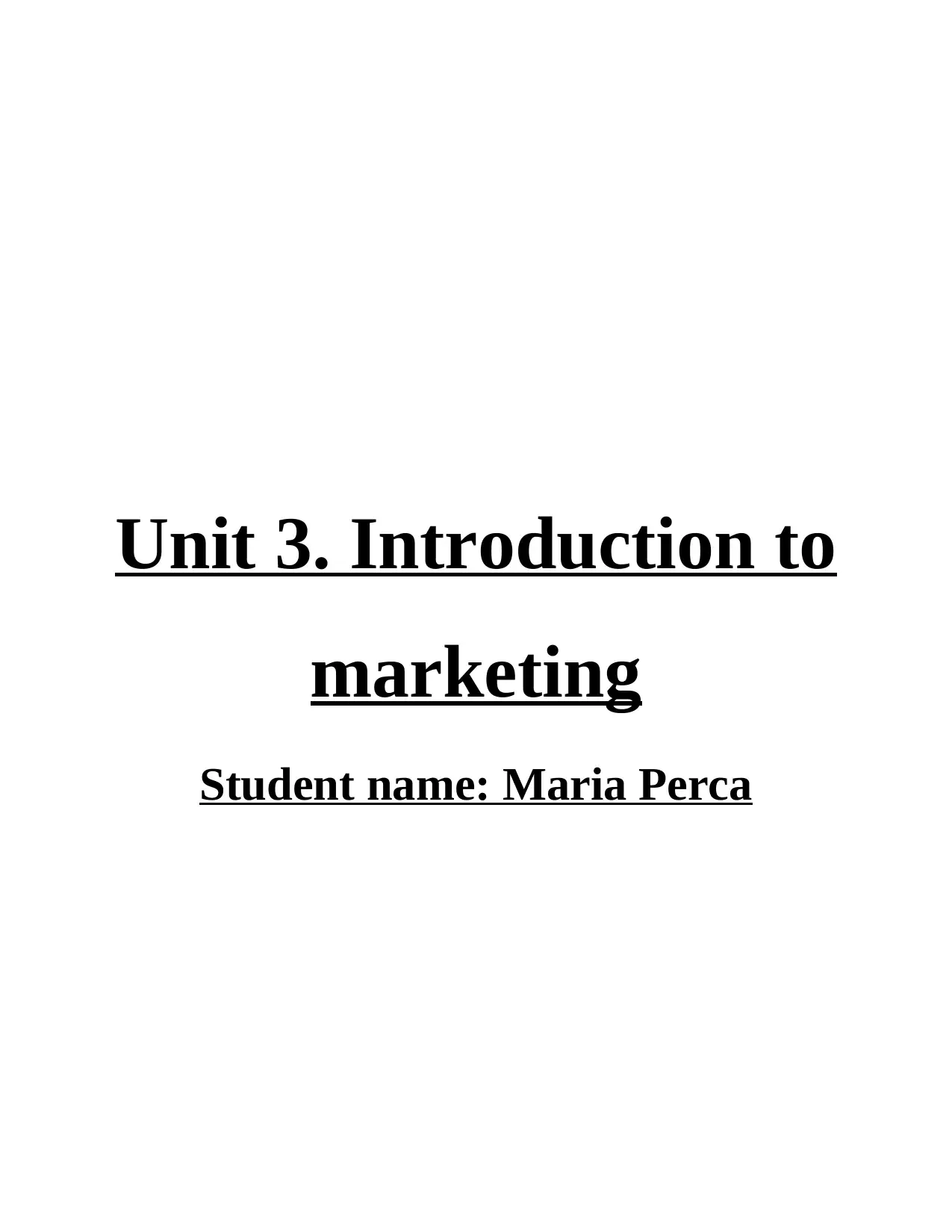
Unit 3. Introduction to
marketing
Student name: Maria Perca
marketing
Student name: Maria Perca
Paraphrase This Document
Need a fresh take? Get an instant paraphrase of this document with our AI Paraphraser
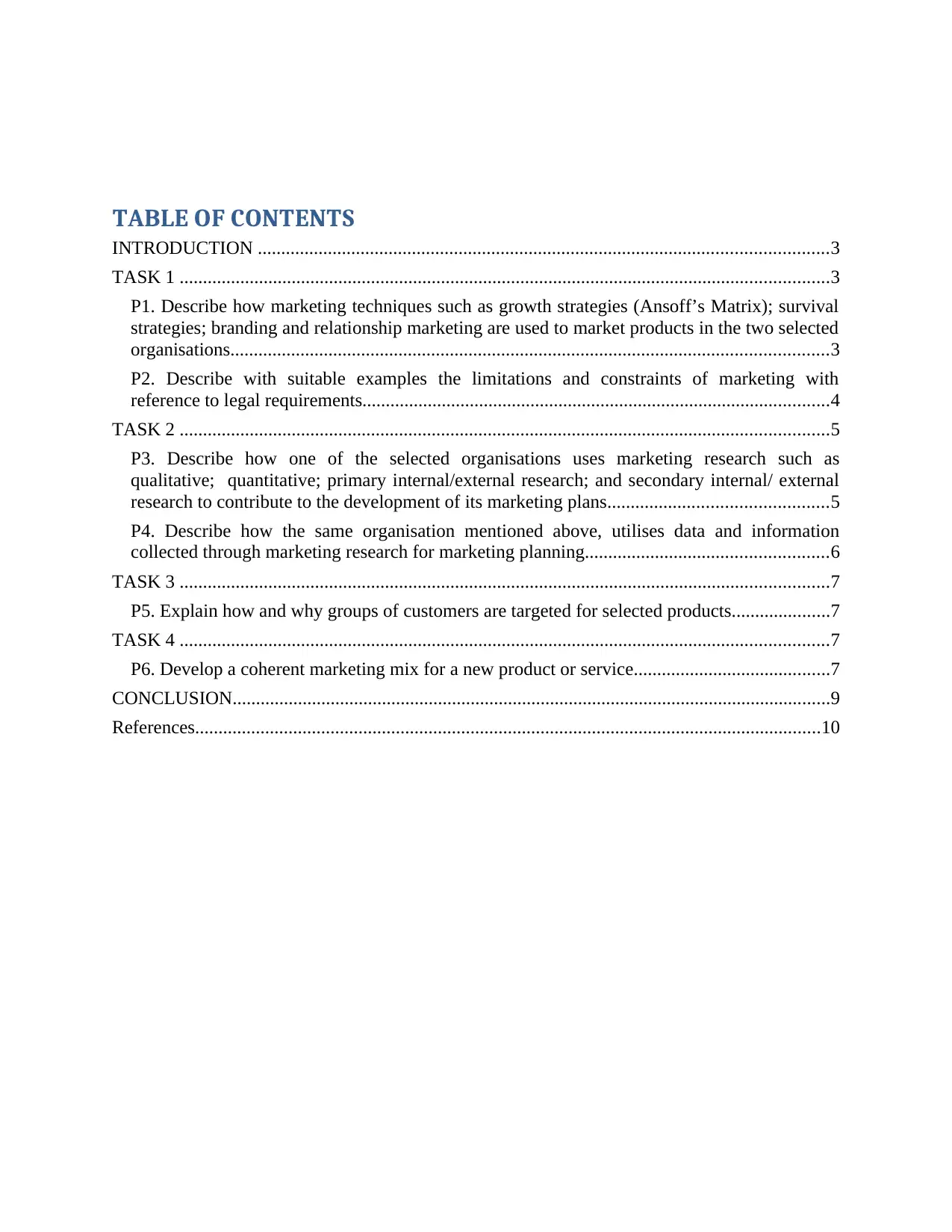
TABLE OF CONTENTS
INTRODUCTION ..........................................................................................................................3
TASK 1 ...........................................................................................................................................3
P1. Describe how marketing techniques such as growth strategies (Ansoff’s Matrix); survival
strategies; branding and relationship marketing are used to market products in the two selected
organisations................................................................................................................................3
P2. Describe with suitable examples the limitations and constraints of marketing with
reference to legal requirements....................................................................................................4
TASK 2 ...........................................................................................................................................5
P3. Describe how one of the selected organisations uses marketing research such as
qualitative; quantitative; primary internal/external research; and secondary internal/ external
research to contribute to the development of its marketing plans...............................................5
P4. Describe how the same organisation mentioned above, utilises data and information
collected through marketing research for marketing planning....................................................6
TASK 3 ...........................................................................................................................................7
P5. Explain how and why groups of customers are targeted for selected products.....................7
TASK 4 ...........................................................................................................................................7
P6. Develop a coherent marketing mix for a new product or service..........................................7
CONCLUSION................................................................................................................................9
References......................................................................................................................................10
INTRODUCTION ..........................................................................................................................3
TASK 1 ...........................................................................................................................................3
P1. Describe how marketing techniques such as growth strategies (Ansoff’s Matrix); survival
strategies; branding and relationship marketing are used to market products in the two selected
organisations................................................................................................................................3
P2. Describe with suitable examples the limitations and constraints of marketing with
reference to legal requirements....................................................................................................4
TASK 2 ...........................................................................................................................................5
P3. Describe how one of the selected organisations uses marketing research such as
qualitative; quantitative; primary internal/external research; and secondary internal/ external
research to contribute to the development of its marketing plans...............................................5
P4. Describe how the same organisation mentioned above, utilises data and information
collected through marketing research for marketing planning....................................................6
TASK 3 ...........................................................................................................................................7
P5. Explain how and why groups of customers are targeted for selected products.....................7
TASK 4 ...........................................................................................................................................7
P6. Develop a coherent marketing mix for a new product or service..........................................7
CONCLUSION................................................................................................................................9
References......................................................................................................................................10
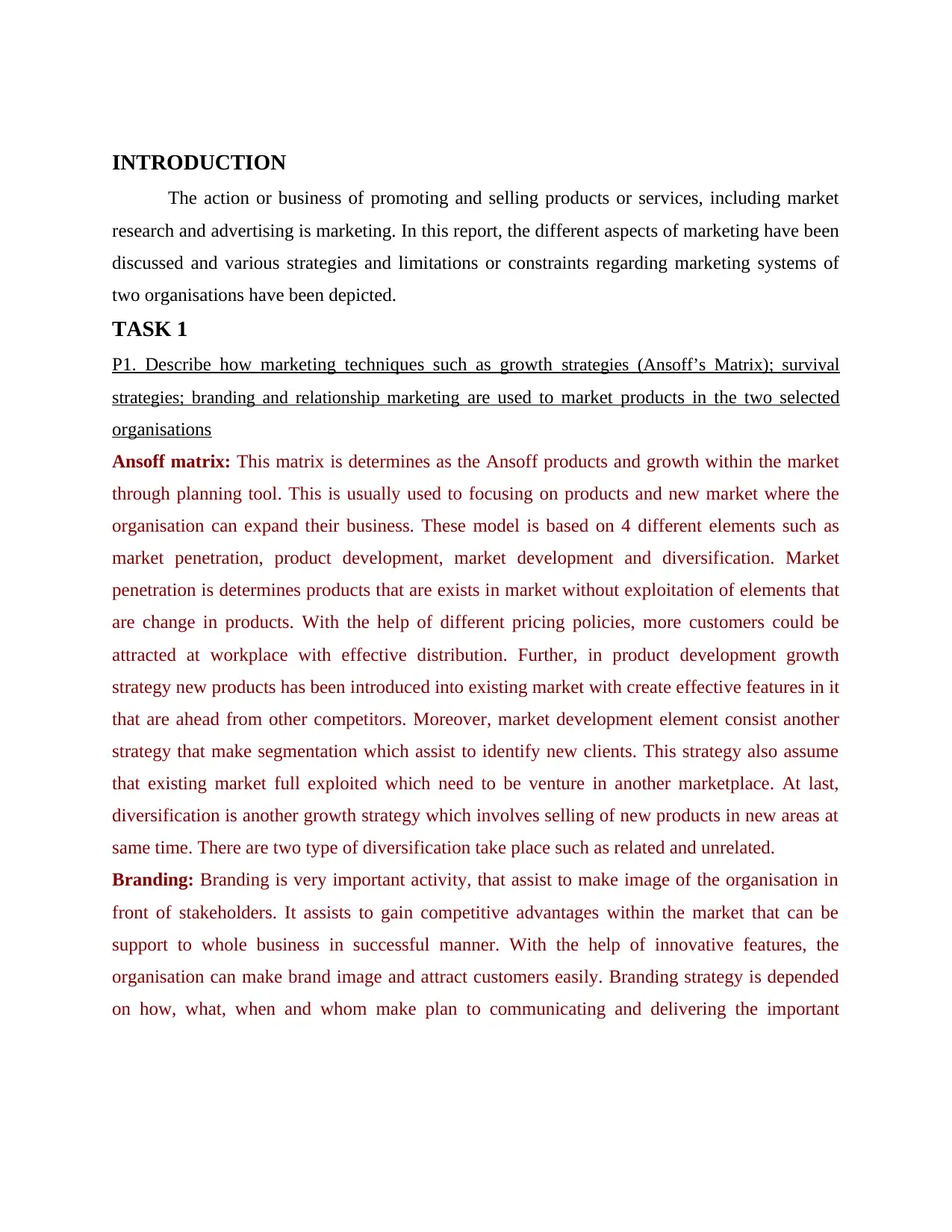
INTRODUCTION
The action or business of promoting and selling products or services, including market
research and advertising is marketing. In this report, the different aspects of marketing have been
discussed and various strategies and limitations or constraints regarding marketing systems of
two organisations have been depicted.
TASK 1
P1. Describe how marketing techniques such as growth strategies (Ansoff’s Matrix); survival
strategies; branding and relationship marketing are used to market products in the two selected
organisations
Ansoff matrix: This matrix is determines as the Ansoff products and growth within the market
through planning tool. This is usually used to focusing on products and new market where the
organisation can expand their business. These model is based on 4 different elements such as
market penetration, product development, market development and diversification. Market
penetration is determines products that are exists in market without exploitation of elements that
are change in products. With the help of different pricing policies, more customers could be
attracted at workplace with effective distribution. Further, in product development growth
strategy new products has been introduced into existing market with create effective features in it
that are ahead from other competitors. Moreover, market development element consist another
strategy that make segmentation which assist to identify new clients. This strategy also assume
that existing market full exploited which need to be venture in another marketplace. At last,
diversification is another growth strategy which involves selling of new products in new areas at
same time. There are two type of diversification take place such as related and unrelated.
Branding: Branding is very important activity, that assist to make image of the organisation in
front of stakeholders. It assists to gain competitive advantages within the market that can be
support to whole business in successful manner. With the help of innovative features, the
organisation can make brand image and attract customers easily. Branding strategy is depended
on how, what, when and whom make plan to communicating and delivering the important
The action or business of promoting and selling products or services, including market
research and advertising is marketing. In this report, the different aspects of marketing have been
discussed and various strategies and limitations or constraints regarding marketing systems of
two organisations have been depicted.
TASK 1
P1. Describe how marketing techniques such as growth strategies (Ansoff’s Matrix); survival
strategies; branding and relationship marketing are used to market products in the two selected
organisations
Ansoff matrix: This matrix is determines as the Ansoff products and growth within the market
through planning tool. This is usually used to focusing on products and new market where the
organisation can expand their business. These model is based on 4 different elements such as
market penetration, product development, market development and diversification. Market
penetration is determines products that are exists in market without exploitation of elements that
are change in products. With the help of different pricing policies, more customers could be
attracted at workplace with effective distribution. Further, in product development growth
strategy new products has been introduced into existing market with create effective features in it
that are ahead from other competitors. Moreover, market development element consist another
strategy that make segmentation which assist to identify new clients. This strategy also assume
that existing market full exploited which need to be venture in another marketplace. At last,
diversification is another growth strategy which involves selling of new products in new areas at
same time. There are two type of diversification take place such as related and unrelated.
Branding: Branding is very important activity, that assist to make image of the organisation in
front of stakeholders. It assists to gain competitive advantages within the market that can be
support to whole business in successful manner. With the help of innovative features, the
organisation can make brand image and attract customers easily. Branding strategy is depended
on how, what, when and whom make plan to communicating and delivering the important
⊘ This is a preview!⊘
Do you want full access?
Subscribe today to unlock all pages.

Trusted by 1+ million students worldwide
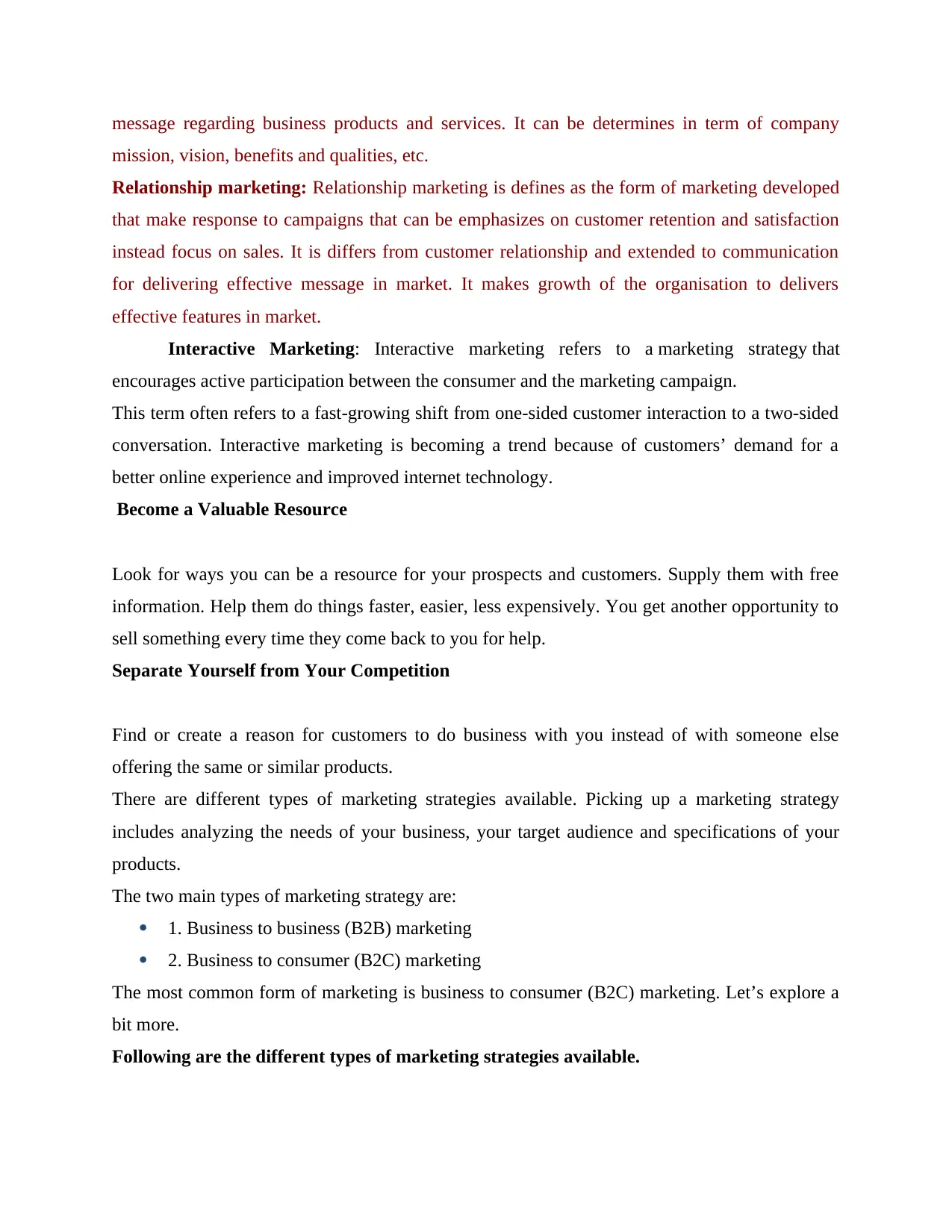
message regarding business products and services. It can be determines in term of company
mission, vision, benefits and qualities, etc.
Relationship marketing: Relationship marketing is defines as the form of marketing developed
that make response to campaigns that can be emphasizes on customer retention and satisfaction
instead focus on sales. It is differs from customer relationship and extended to communication
for delivering effective message in market. It makes growth of the organisation to delivers
effective features in market.
Interactive Marketing: Interactive marketing refers to a marketing strategy that
encourages active participation between the consumer and the marketing campaign.
This term often refers to a fast-growing shift from one-sided customer interaction to a two-sided
conversation. Interactive marketing is becoming a trend because of customers’ demand for a
better online experience and improved internet technology.
Become a Valuable Resource
Look for ways you can be a resource for your prospects and customers. Supply them with free
information. Help them do things faster, easier, less expensively. You get another opportunity to
sell something every time they come back to you for help.
Separate Yourself from Your Competition
Find or create a reason for customers to do business with you instead of with someone else
offering the same or similar products.
There are different types of marketing strategies available. Picking up a marketing strategy
includes analyzing the needs of your business, your target audience and specifications of your
products.
The two main types of marketing strategy are:
1. Business to business (B2B) marketing
2. Business to consumer (B2C) marketing
The most common form of marketing is business to consumer (B2C) marketing. Let’s explore a
bit more.
Following are the different types of marketing strategies available.
mission, vision, benefits and qualities, etc.
Relationship marketing: Relationship marketing is defines as the form of marketing developed
that make response to campaigns that can be emphasizes on customer retention and satisfaction
instead focus on sales. It is differs from customer relationship and extended to communication
for delivering effective message in market. It makes growth of the organisation to delivers
effective features in market.
Interactive Marketing: Interactive marketing refers to a marketing strategy that
encourages active participation between the consumer and the marketing campaign.
This term often refers to a fast-growing shift from one-sided customer interaction to a two-sided
conversation. Interactive marketing is becoming a trend because of customers’ demand for a
better online experience and improved internet technology.
Become a Valuable Resource
Look for ways you can be a resource for your prospects and customers. Supply them with free
information. Help them do things faster, easier, less expensively. You get another opportunity to
sell something every time they come back to you for help.
Separate Yourself from Your Competition
Find or create a reason for customers to do business with you instead of with someone else
offering the same or similar products.
There are different types of marketing strategies available. Picking up a marketing strategy
includes analyzing the needs of your business, your target audience and specifications of your
products.
The two main types of marketing strategy are:
1. Business to business (B2B) marketing
2. Business to consumer (B2C) marketing
The most common form of marketing is business to consumer (B2C) marketing. Let’s explore a
bit more.
Following are the different types of marketing strategies available.
Paraphrase This Document
Need a fresh take? Get an instant paraphrase of this document with our AI Paraphraser

1. Paid advertising
This includes multiple approaches for marketing. It includes traditional approaches like TVCs
and print media advertising. Also, one of the most well-known marketing approach is internet
marketing. It includes various methods like PPC (Pay per click) and paid advertising.
2. Cause marketing
Cause marketing links the services and products of a company to a social cause or issue. It is also
well known as cause related marketing.
3. Relationship marketing
This type of marketing is basically focused on customer building. Enhancing existing
relationships with customers and improving customer loyalty.
P2. Describe with suitable examples the limitations and constraints of marketing with reference
to legal requirements
Legal & ethical constraints
Computer Misuse Act 1990: This act is refers as the new offences such as unauthorised
access to computer material, unauthorised access of intent facility or crime and making supply of
obtaining anything which used in computer. Therefore, this act is made to maintain security in
computer criminals.
Sale of Good Act: This law is related to sales and purchase of goods that prior to
determines special provisions with government provisions. In this aspect, general law of contract
is applicable to determines transfer the property of good to any person.
Freedom of Information Act: This act is generally provides right to request of a person
to access records and information that are protected by him or her to disclose in front of any
other person. There are nine exemptions are contained in law with three special records
exclusions.
The Data Protection Act (1998) is a good example of a law that has several implications
for market researchers collecting and holding personal data. For instance, researchers must
ensure that the data they obtain is kept secure, is only used for lawful purposes and is only kept
for as long as it is necessary. It must be made clear as to why data is being collected and the
consent of participants must be obtained. In addition to this, there are several guidelines, laid
This includes multiple approaches for marketing. It includes traditional approaches like TVCs
and print media advertising. Also, one of the most well-known marketing approach is internet
marketing. It includes various methods like PPC (Pay per click) and paid advertising.
2. Cause marketing
Cause marketing links the services and products of a company to a social cause or issue. It is also
well known as cause related marketing.
3. Relationship marketing
This type of marketing is basically focused on customer building. Enhancing existing
relationships with customers and improving customer loyalty.
P2. Describe with suitable examples the limitations and constraints of marketing with reference
to legal requirements
Legal & ethical constraints
Computer Misuse Act 1990: This act is refers as the new offences such as unauthorised
access to computer material, unauthorised access of intent facility or crime and making supply of
obtaining anything which used in computer. Therefore, this act is made to maintain security in
computer criminals.
Sale of Good Act: This law is related to sales and purchase of goods that prior to
determines special provisions with government provisions. In this aspect, general law of contract
is applicable to determines transfer the property of good to any person.
Freedom of Information Act: This act is generally provides right to request of a person
to access records and information that are protected by him or her to disclose in front of any
other person. There are nine exemptions are contained in law with three special records
exclusions.
The Data Protection Act (1998) is a good example of a law that has several implications
for market researchers collecting and holding personal data. For instance, researchers must
ensure that the data they obtain is kept secure, is only used for lawful purposes and is only kept
for as long as it is necessary. It must be made clear as to why data is being collected and the
consent of participants must be obtained. In addition to this, there are several guidelines, laid
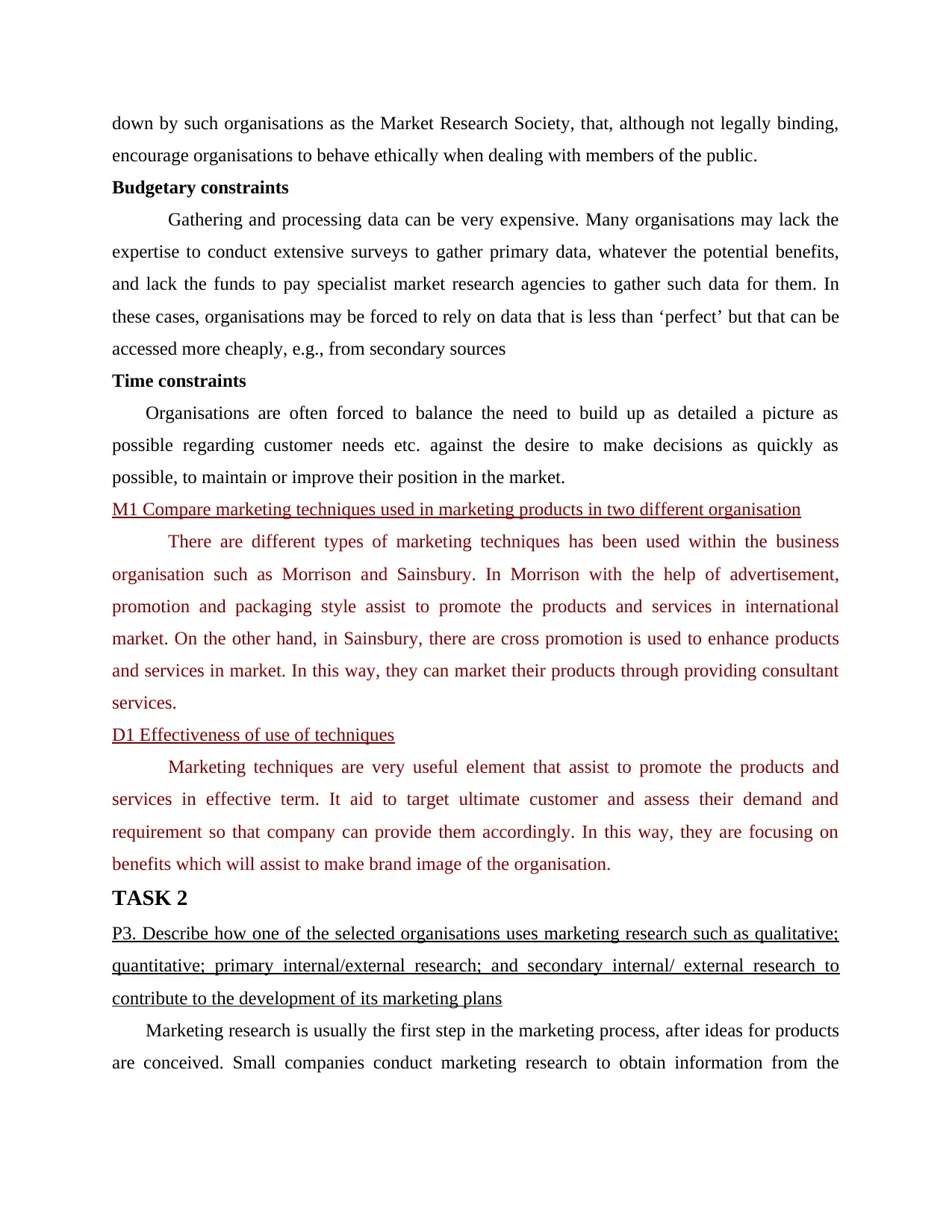
down by such organisations as the Market Research Society, that, although not legally binding,
encourage organisations to behave ethically when dealing with members of the public.
Budgetary constraints
Gathering and processing data can be very expensive. Many organisations may lack the
expertise to conduct extensive surveys to gather primary data, whatever the potential benefits,
and lack the funds to pay specialist market research agencies to gather such data for them. In
these cases, organisations may be forced to rely on data that is less than ‘perfect’ but that can be
accessed more cheaply, e.g., from secondary sources
Time constraints
Organisations are often forced to balance the need to build up as detailed a picture as
possible regarding customer needs etc. against the desire to make decisions as quickly as
possible, to maintain or improve their position in the market.
M1 Compare marketing techniques used in marketing products in two different organisation
There are different types of marketing techniques has been used within the business
organisation such as Morrison and Sainsbury. In Morrison with the help of advertisement,
promotion and packaging style assist to promote the products and services in international
market. On the other hand, in Sainsbury, there are cross promotion is used to enhance products
and services in market. In this way, they can market their products through providing consultant
services.
D1 Effectiveness of use of techniques
Marketing techniques are very useful element that assist to promote the products and
services in effective term. It aid to target ultimate customer and assess their demand and
requirement so that company can provide them accordingly. In this way, they are focusing on
benefits which will assist to make brand image of the organisation.
TASK 2
P3. Describe how one of the selected organisations uses marketing research such as qualitative;
quantitative; primary internal/external research; and secondary internal/ external research to
contribute to the development of its marketing plans
Marketing research is usually the first step in the marketing process, after ideas for products
are conceived. Small companies conduct marketing research to obtain information from the
encourage organisations to behave ethically when dealing with members of the public.
Budgetary constraints
Gathering and processing data can be very expensive. Many organisations may lack the
expertise to conduct extensive surveys to gather primary data, whatever the potential benefits,
and lack the funds to pay specialist market research agencies to gather such data for them. In
these cases, organisations may be forced to rely on data that is less than ‘perfect’ but that can be
accessed more cheaply, e.g., from secondary sources
Time constraints
Organisations are often forced to balance the need to build up as detailed a picture as
possible regarding customer needs etc. against the desire to make decisions as quickly as
possible, to maintain or improve their position in the market.
M1 Compare marketing techniques used in marketing products in two different organisation
There are different types of marketing techniques has been used within the business
organisation such as Morrison and Sainsbury. In Morrison with the help of advertisement,
promotion and packaging style assist to promote the products and services in international
market. On the other hand, in Sainsbury, there are cross promotion is used to enhance products
and services in market. In this way, they can market their products through providing consultant
services.
D1 Effectiveness of use of techniques
Marketing techniques are very useful element that assist to promote the products and
services in effective term. It aid to target ultimate customer and assess their demand and
requirement so that company can provide them accordingly. In this way, they are focusing on
benefits which will assist to make brand image of the organisation.
TASK 2
P3. Describe how one of the selected organisations uses marketing research such as qualitative;
quantitative; primary internal/external research; and secondary internal/ external research to
contribute to the development of its marketing plans
Marketing research is usually the first step in the marketing process, after ideas for products
are conceived. Small companies conduct marketing research to obtain information from the
⊘ This is a preview!⊘
Do you want full access?
Subscribe today to unlock all pages.

Trusted by 1+ million students worldwide
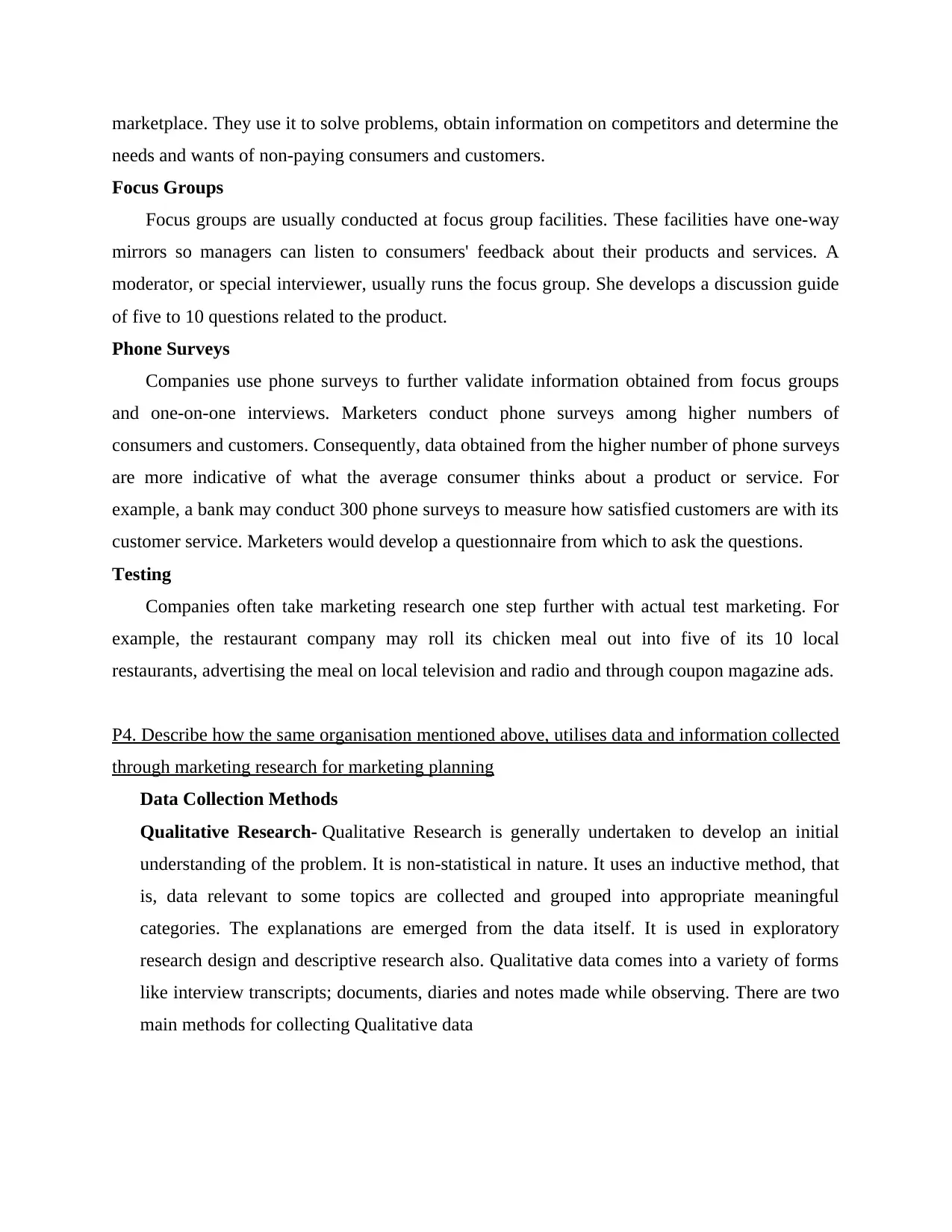
marketplace. They use it to solve problems, obtain information on competitors and determine the
needs and wants of non-paying consumers and customers.
Focus Groups
Focus groups are usually conducted at focus group facilities. These facilities have one-way
mirrors so managers can listen to consumers' feedback about their products and services. A
moderator, or special interviewer, usually runs the focus group. She develops a discussion guide
of five to 10 questions related to the product.
Phone Surveys
Companies use phone surveys to further validate information obtained from focus groups
and one-on-one interviews. Marketers conduct phone surveys among higher numbers of
consumers and customers. Consequently, data obtained from the higher number of phone surveys
are more indicative of what the average consumer thinks about a product or service. For
example, a bank may conduct 300 phone surveys to measure how satisfied customers are with its
customer service. Marketers would develop a questionnaire from which to ask the questions.
Testing
Companies often take marketing research one step further with actual test marketing. For
example, the restaurant company may roll its chicken meal out into five of its 10 local
restaurants, advertising the meal on local television and radio and through coupon magazine ads.
P4. Describe how the same organisation mentioned above, utilises data and information collected
through marketing research for marketing planning
Data Collection Methods
Qualitative Research- Qualitative Research is generally undertaken to develop an initial
understanding of the problem. It is non-statistical in nature. It uses an inductive method, that
is, data relevant to some topics are collected and grouped into appropriate meaningful
categories. The explanations are emerged from the data itself. It is used in exploratory
research design and descriptive research also. Qualitative data comes into a variety of forms
like interview transcripts; documents, diaries and notes made while observing. There are two
main methods for collecting Qualitative data
needs and wants of non-paying consumers and customers.
Focus Groups
Focus groups are usually conducted at focus group facilities. These facilities have one-way
mirrors so managers can listen to consumers' feedback about their products and services. A
moderator, or special interviewer, usually runs the focus group. She develops a discussion guide
of five to 10 questions related to the product.
Phone Surveys
Companies use phone surveys to further validate information obtained from focus groups
and one-on-one interviews. Marketers conduct phone surveys among higher numbers of
consumers and customers. Consequently, data obtained from the higher number of phone surveys
are more indicative of what the average consumer thinks about a product or service. For
example, a bank may conduct 300 phone surveys to measure how satisfied customers are with its
customer service. Marketers would develop a questionnaire from which to ask the questions.
Testing
Companies often take marketing research one step further with actual test marketing. For
example, the restaurant company may roll its chicken meal out into five of its 10 local
restaurants, advertising the meal on local television and radio and through coupon magazine ads.
P4. Describe how the same organisation mentioned above, utilises data and information collected
through marketing research for marketing planning
Data Collection Methods
Qualitative Research- Qualitative Research is generally undertaken to develop an initial
understanding of the problem. It is non-statistical in nature. It uses an inductive method, that
is, data relevant to some topics are collected and grouped into appropriate meaningful
categories. The explanations are emerged from the data itself. It is used in exploratory
research design and descriptive research also. Qualitative data comes into a variety of forms
like interview transcripts; documents, diaries and notes made while observing. There are two
main methods for collecting Qualitative data
Paraphrase This Document
Need a fresh take? Get an instant paraphrase of this document with our AI Paraphraser
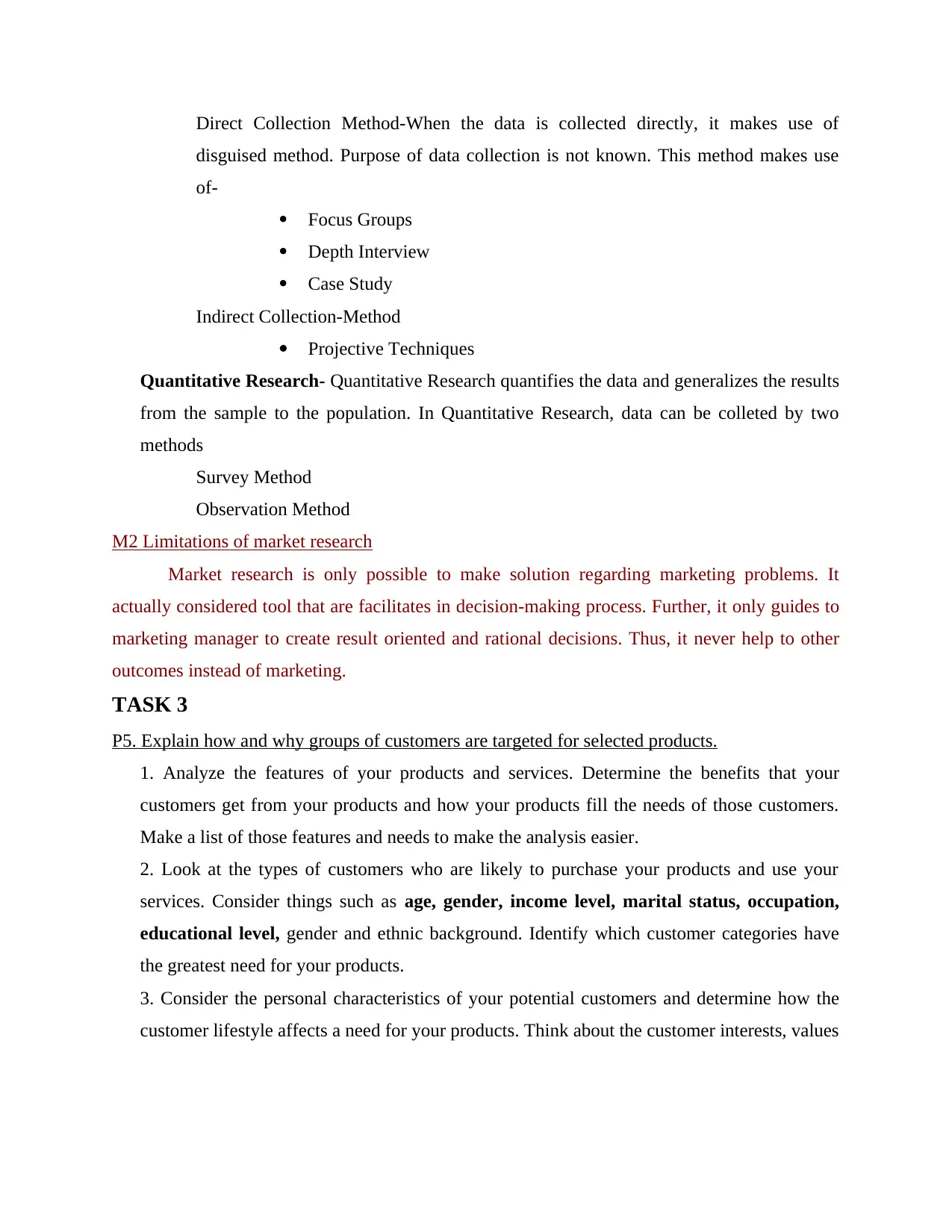
Direct Collection Method-When the data is collected directly, it makes use of
disguised method. Purpose of data collection is not known. This method makes use
of-
Focus Groups
Depth Interview
Case Study
Indirect Collection-Method
Projective Techniques
Quantitative Research- Quantitative Research quantifies the data and generalizes the results
from the sample to the population. In Quantitative Research, data can be colleted by two
methods
Survey Method
Observation Method
M2 Limitations of market research
Market research is only possible to make solution regarding marketing problems. It
actually considered tool that are facilitates in decision-making process. Further, it only guides to
marketing manager to create result oriented and rational decisions. Thus, it never help to other
outcomes instead of marketing.
TASK 3
P5. Explain how and why groups of customers are targeted for selected products.
1. Analyze the features of your products and services. Determine the benefits that your
customers get from your products and how your products fill the needs of those customers.
Make a list of those features and needs to make the analysis easier.
2. Look at the types of customers who are likely to purchase your products and use your
services. Consider things such as age, gender, income level, marital status, occupation,
educational level, gender and ethnic background. Identify which customer categories have
the greatest need for your products.
3. Consider the personal characteristics of your potential customers and determine how the
customer lifestyle affects a need for your products. Think about the customer interests, values
disguised method. Purpose of data collection is not known. This method makes use
of-
Focus Groups
Depth Interview
Case Study
Indirect Collection-Method
Projective Techniques
Quantitative Research- Quantitative Research quantifies the data and generalizes the results
from the sample to the population. In Quantitative Research, data can be colleted by two
methods
Survey Method
Observation Method
M2 Limitations of market research
Market research is only possible to make solution regarding marketing problems. It
actually considered tool that are facilitates in decision-making process. Further, it only guides to
marketing manager to create result oriented and rational decisions. Thus, it never help to other
outcomes instead of marketing.
TASK 3
P5. Explain how and why groups of customers are targeted for selected products.
1. Analyze the features of your products and services. Determine the benefits that your
customers get from your products and how your products fill the needs of those customers.
Make a list of those features and needs to make the analysis easier.
2. Look at the types of customers who are likely to purchase your products and use your
services. Consider things such as age, gender, income level, marital status, occupation,
educational level, gender and ethnic background. Identify which customer categories have
the greatest need for your products.
3. Consider the personal characteristics of your potential customers and determine how the
customer lifestyle affects a need for your products. Think about the customer interests, values
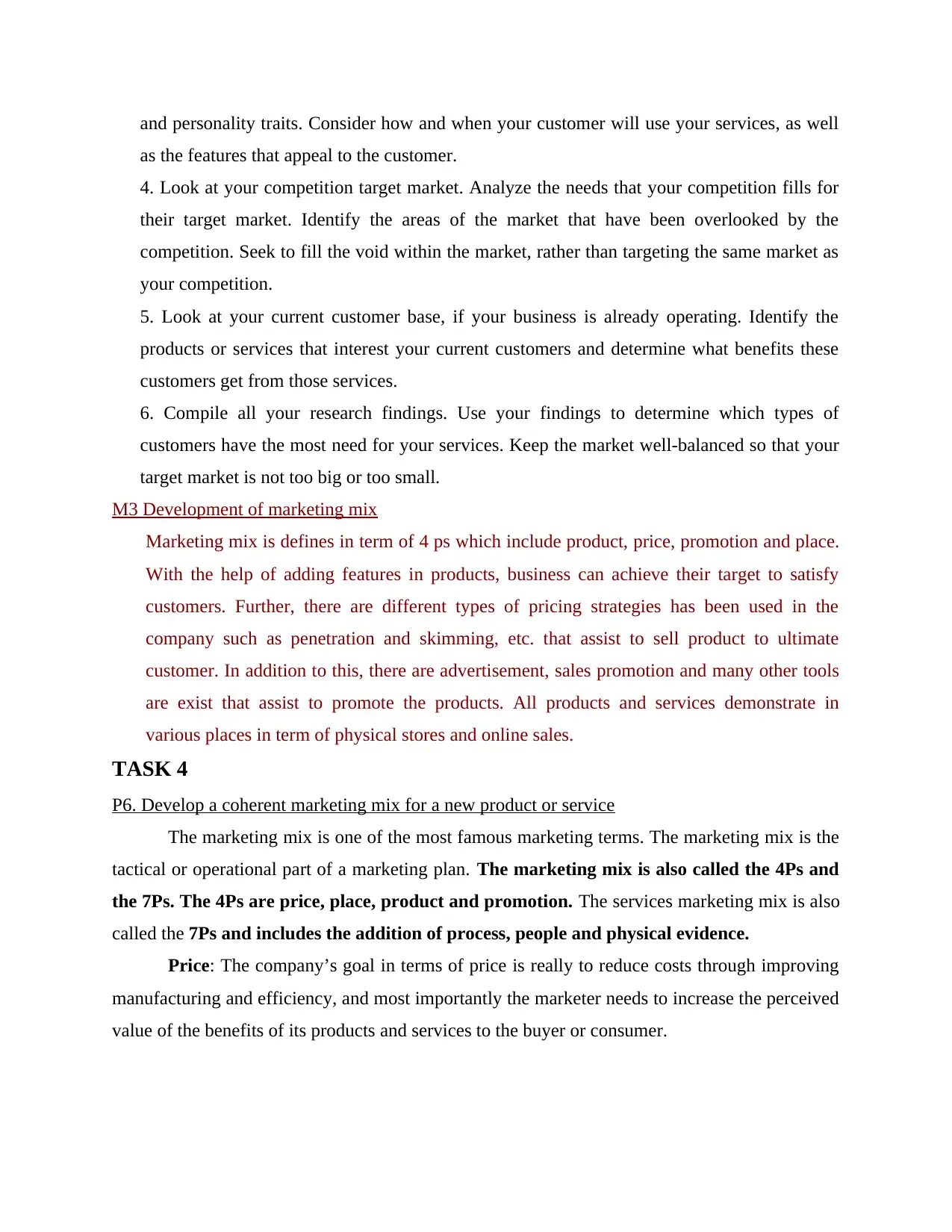
and personality traits. Consider how and when your customer will use your services, as well
as the features that appeal to the customer.
4. Look at your competition target market. Analyze the needs that your competition fills for
their target market. Identify the areas of the market that have been overlooked by the
competition. Seek to fill the void within the market, rather than targeting the same market as
your competition.
5. Look at your current customer base, if your business is already operating. Identify the
products or services that interest your current customers and determine what benefits these
customers get from those services.
6. Compile all your research findings. Use your findings to determine which types of
customers have the most need for your services. Keep the market well-balanced so that your
target market is not too big or too small.
M3 Development of marketing mix
Marketing mix is defines in term of 4 ps which include product, price, promotion and place.
With the help of adding features in products, business can achieve their target to satisfy
customers. Further, there are different types of pricing strategies has been used in the
company such as penetration and skimming, etc. that assist to sell product to ultimate
customer. In addition to this, there are advertisement, sales promotion and many other tools
are exist that assist to promote the products. All products and services demonstrate in
various places in term of physical stores and online sales.
TASK 4
P6. Develop a coherent marketing mix for a new product or service
The marketing mix is one of the most famous marketing terms. The marketing mix is the
tactical or operational part of a marketing plan. The marketing mix is also called the 4Ps and
the 7Ps. The 4Ps are price, place, product and promotion. The services marketing mix is also
called the 7Ps and includes the addition of process, people and physical evidence.
Price: The company’s goal in terms of price is really to reduce costs through improving
manufacturing and efficiency, and most importantly the marketer needs to increase the perceived
value of the benefits of its products and services to the buyer or consumer.
as the features that appeal to the customer.
4. Look at your competition target market. Analyze the needs that your competition fills for
their target market. Identify the areas of the market that have been overlooked by the
competition. Seek to fill the void within the market, rather than targeting the same market as
your competition.
5. Look at your current customer base, if your business is already operating. Identify the
products or services that interest your current customers and determine what benefits these
customers get from those services.
6. Compile all your research findings. Use your findings to determine which types of
customers have the most need for your services. Keep the market well-balanced so that your
target market is not too big or too small.
M3 Development of marketing mix
Marketing mix is defines in term of 4 ps which include product, price, promotion and place.
With the help of adding features in products, business can achieve their target to satisfy
customers. Further, there are different types of pricing strategies has been used in the
company such as penetration and skimming, etc. that assist to sell product to ultimate
customer. In addition to this, there are advertisement, sales promotion and many other tools
are exist that assist to promote the products. All products and services demonstrate in
various places in term of physical stores and online sales.
TASK 4
P6. Develop a coherent marketing mix for a new product or service
The marketing mix is one of the most famous marketing terms. The marketing mix is the
tactical or operational part of a marketing plan. The marketing mix is also called the 4Ps and
the 7Ps. The 4Ps are price, place, product and promotion. The services marketing mix is also
called the 7Ps and includes the addition of process, people and physical evidence.
Price: The company’s goal in terms of price is really to reduce costs through improving
manufacturing and efficiency, and most importantly the marketer needs to increase the perceived
value of the benefits of its products and services to the buyer or consumer.
⊘ This is a preview!⊘
Do you want full access?
Subscribe today to unlock all pages.

Trusted by 1+ million students worldwide

There are many ways to price a product. Let’s have a look at some of them and try to understand
the best policy/strategy in various
situations.
Place: Place is also known as channel, distribution, or intermediary. It is the mechanism
through which goods and/or services are moved from the manufacturer/ service provider to the
user or consumer.
Product: For many a product is simply the tangible, physical item that we buy or sell.
You can also think of the product as intangible i.e. a service.
To actively explore the nature of a product further, let’s consider it as three different
products – the CORE product, the ACTUAL product, and finally the AUGMENTED product.
The Product Life Cycle (PLC) is based upon the biological life cycle. For example, a
seed is planted (introduction); it begins to sprout (growth); it shoots out leaves and puts down
roots as it becomes an adult (maturity); after a long period as an adult the plant begins to shrink
and die out (decline).
The Customer Life Cycle (CLC) has obvious similarities with the Product Life Cycle
(PLC). However, CLC focuses upon the creation and delivery of lifetime value to the customer
i.e. looks at the products or services that customers NEED throughout their lives.
Promotion
Promotion includes all the tools available to the marketer for marketing communication.
As with Neil H. Borden’s marketing mix, marketing communications has its own promotions
mix. Whilst there is no absolute agreement on the specific content of a marketing
communications mix, there are many promotions elements that are often included such as sales,
advertising, sales promotion, public relations, direct marketing, online communications and
personal selling.
Physical Evidence
Physical Evidence is the material part of a service. Strictly speaking there are no physical
attributes to a service, so a consumer tends to rely on material cues. There are many examples of
the best policy/strategy in various
situations.
Place: Place is also known as channel, distribution, or intermediary. It is the mechanism
through which goods and/or services are moved from the manufacturer/ service provider to the
user or consumer.
Product: For many a product is simply the tangible, physical item that we buy or sell.
You can also think of the product as intangible i.e. a service.
To actively explore the nature of a product further, let’s consider it as three different
products – the CORE product, the ACTUAL product, and finally the AUGMENTED product.
The Product Life Cycle (PLC) is based upon the biological life cycle. For example, a
seed is planted (introduction); it begins to sprout (growth); it shoots out leaves and puts down
roots as it becomes an adult (maturity); after a long period as an adult the plant begins to shrink
and die out (decline).
The Customer Life Cycle (CLC) has obvious similarities with the Product Life Cycle
(PLC). However, CLC focuses upon the creation and delivery of lifetime value to the customer
i.e. looks at the products or services that customers NEED throughout their lives.
Promotion
Promotion includes all the tools available to the marketer for marketing communication.
As with Neil H. Borden’s marketing mix, marketing communications has its own promotions
mix. Whilst there is no absolute agreement on the specific content of a marketing
communications mix, there are many promotions elements that are often included such as sales,
advertising, sales promotion, public relations, direct marketing, online communications and
personal selling.
Physical Evidence
Physical Evidence is the material part of a service. Strictly speaking there are no physical
attributes to a service, so a consumer tends to rely on material cues. There are many examples of
Paraphrase This Document
Need a fresh take? Get an instant paraphrase of this document with our AI Paraphraser

physical evidence, including some of the following buildings, equipment, signs and logos, annual
accounts and business reports, brochures, your website, and even your business cards.
People
People are the most important element of any service or experience. Services tend to be
produced and consumed at the same moment, and aspects of the customer experience are altered
to meet the individual needs of the person consuming it.
Process
There are several perceptions of the concept of process within the business and marketing
literature. Some see processes to achieve an outcome, for example – to achieve a 30% market
share a company implements a marketing planning process. However in reality it is more about
the customer interface between the business and consumer and how they deal with each other in
a series of steps in stages, i.e. throughout the process.
D2 Recommendations
In order to provide recommendation, it should be said that the enterprise need to focus on
online promotional techniques. This is because, in modern marketing every customer demanded
technical assistance at right time. Thus, business need to provide products and services at low
cost so that it would be helpful to develop effective results at workplace. Through assess
customer demand and requirement, the company can easily get more profits and revenue to serve
them products and services.
CONCLUSION
Running a business is never a sure bet, but sometimes it can feel like you're caught between
the proverbial rock and hard place. Thanks to the Internet, you can reach customers outside of
your local area. But at the same time, your customers find it easy to go online and compare
prices, find product information and make purchases from companies across the country, or
across the world.
accounts and business reports, brochures, your website, and even your business cards.
People
People are the most important element of any service or experience. Services tend to be
produced and consumed at the same moment, and aspects of the customer experience are altered
to meet the individual needs of the person consuming it.
Process
There are several perceptions of the concept of process within the business and marketing
literature. Some see processes to achieve an outcome, for example – to achieve a 30% market
share a company implements a marketing planning process. However in reality it is more about
the customer interface between the business and consumer and how they deal with each other in
a series of steps in stages, i.e. throughout the process.
D2 Recommendations
In order to provide recommendation, it should be said that the enterprise need to focus on
online promotional techniques. This is because, in modern marketing every customer demanded
technical assistance at right time. Thus, business need to provide products and services at low
cost so that it would be helpful to develop effective results at workplace. Through assess
customer demand and requirement, the company can easily get more profits and revenue to serve
them products and services.
CONCLUSION
Running a business is never a sure bet, but sometimes it can feel like you're caught between
the proverbial rock and hard place. Thanks to the Internet, you can reach customers outside of
your local area. But at the same time, your customers find it easy to go online and compare
prices, find product information and make purchases from companies across the country, or
across the world.
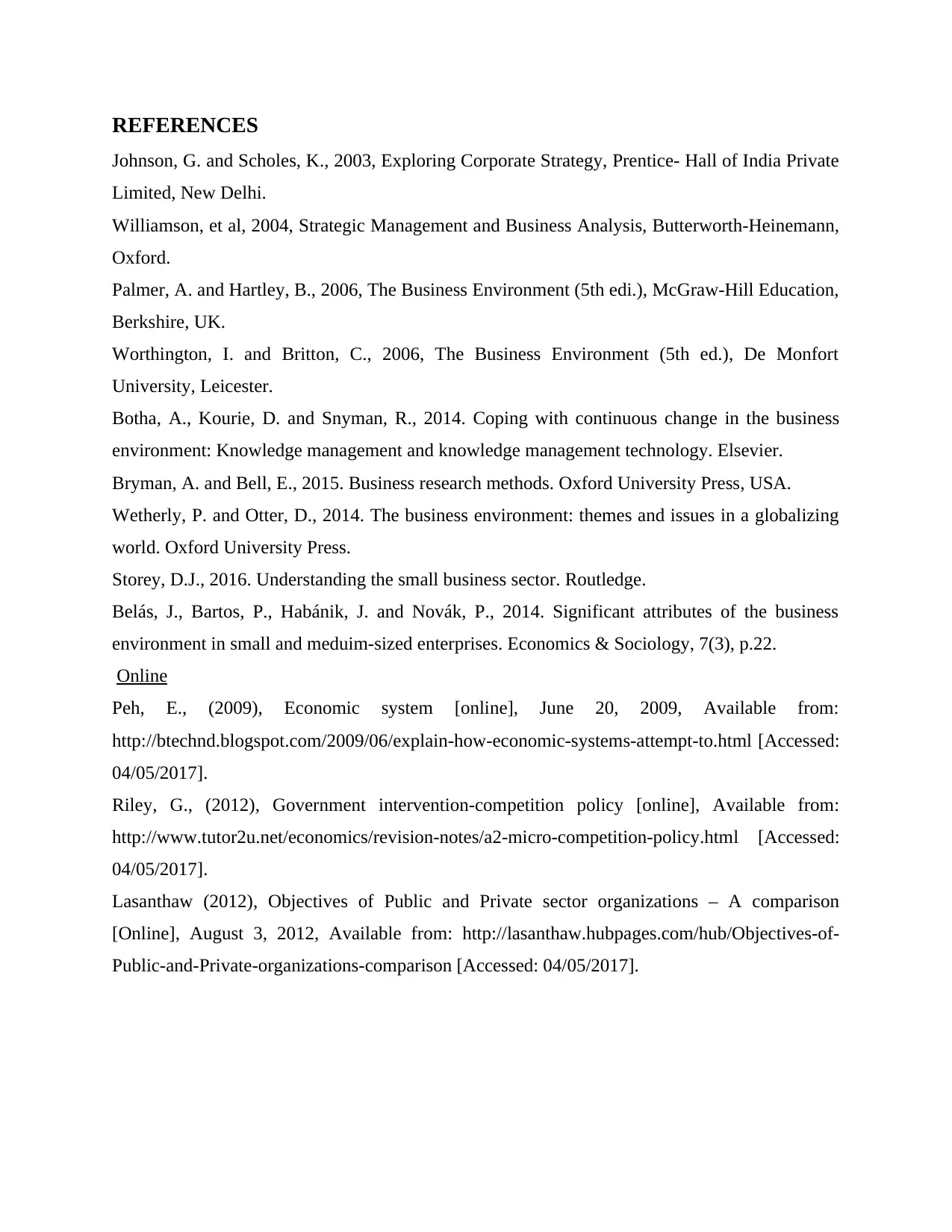
REFERENCES
Johnson, G. and Scholes, K., 2003, Exploring Corporate Strategy, Prentice- Hall of India Private
Limited, New Delhi.
Williamson, et al, 2004, Strategic Management and Business Analysis, Butterworth-Heinemann,
Oxford.
Palmer, A. and Hartley, B., 2006, The Business Environment (5th edi.), McGraw-Hill Education,
Berkshire, UK.
Worthington, I. and Britton, C., 2006, The Business Environment (5th ed.), De Monfort
University, Leicester.
Botha, A., Kourie, D. and Snyman, R., 2014. Coping with continuous change in the business
environment: Knowledge management and knowledge management technology. Elsevier.
Bryman, A. and Bell, E., 2015. Business research methods. Oxford University Press, USA.
Wetherly, P. and Otter, D., 2014. The business environment: themes and issues in a globalizing
world. Oxford University Press.
Storey, D.J., 2016. Understanding the small business sector. Routledge.
Belás, J., Bartos, P., Habánik, J. and Novák, P., 2014. Significant attributes of the business
environment in small and meduim-sized enterprises. Economics & Sociology, 7(3), p.22.
Online
Peh, E., (2009), Economic system [online], June 20, 2009, Available from:
http://btechnd.blogspot.com/2009/06/explain-how-economic-systems-attempt-to.html [Accessed:
04/05/2017].
Riley, G., (2012), Government intervention-competition policy [online], Available from:
http://www.tutor2u.net/economics/revision-notes/a2-micro-competition-policy.html [Accessed:
04/05/2017].
Lasanthaw (2012), Objectives of Public and Private sector organizations – A comparison
[Online], August 3, 2012, Available from: http://lasanthaw.hubpages.com/hub/Objectives-of-
Public-and-Private-organizations-comparison [Accessed: 04/05/2017].
Johnson, G. and Scholes, K., 2003, Exploring Corporate Strategy, Prentice- Hall of India Private
Limited, New Delhi.
Williamson, et al, 2004, Strategic Management and Business Analysis, Butterworth-Heinemann,
Oxford.
Palmer, A. and Hartley, B., 2006, The Business Environment (5th edi.), McGraw-Hill Education,
Berkshire, UK.
Worthington, I. and Britton, C., 2006, The Business Environment (5th ed.), De Monfort
University, Leicester.
Botha, A., Kourie, D. and Snyman, R., 2014. Coping with continuous change in the business
environment: Knowledge management and knowledge management technology. Elsevier.
Bryman, A. and Bell, E., 2015. Business research methods. Oxford University Press, USA.
Wetherly, P. and Otter, D., 2014. The business environment: themes and issues in a globalizing
world. Oxford University Press.
Storey, D.J., 2016. Understanding the small business sector. Routledge.
Belás, J., Bartos, P., Habánik, J. and Novák, P., 2014. Significant attributes of the business
environment in small and meduim-sized enterprises. Economics & Sociology, 7(3), p.22.
Online
Peh, E., (2009), Economic system [online], June 20, 2009, Available from:
http://btechnd.blogspot.com/2009/06/explain-how-economic-systems-attempt-to.html [Accessed:
04/05/2017].
Riley, G., (2012), Government intervention-competition policy [online], Available from:
http://www.tutor2u.net/economics/revision-notes/a2-micro-competition-policy.html [Accessed:
04/05/2017].
Lasanthaw (2012), Objectives of Public and Private sector organizations – A comparison
[Online], August 3, 2012, Available from: http://lasanthaw.hubpages.com/hub/Objectives-of-
Public-and-Private-organizations-comparison [Accessed: 04/05/2017].
⊘ This is a preview!⊘
Do you want full access?
Subscribe today to unlock all pages.

Trusted by 1+ million students worldwide
1 out of 14
Related Documents
Your All-in-One AI-Powered Toolkit for Academic Success.
+13062052269
info@desklib.com
Available 24*7 on WhatsApp / Email
![[object Object]](/_next/static/media/star-bottom.7253800d.svg)
Unlock your academic potential
Copyright © 2020–2025 A2Z Services. All Rights Reserved. Developed and managed by ZUCOL.





